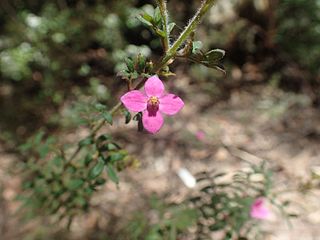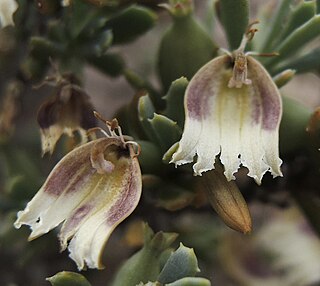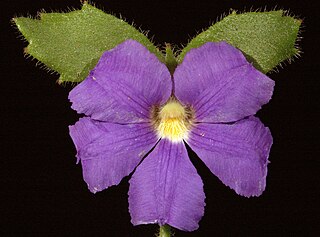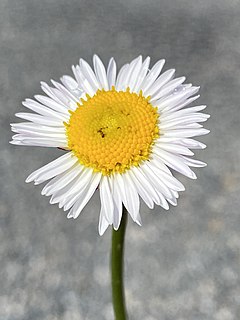Eremophila eriocalyx, commonly known as desert pride, is a flowering plant in the figwort family, Scrophulariaceae and is endemic to Western Australia. It is an erect shrub with greyish leaves, very hairy sepals and petals that range in colour from white to yellow, sometimes pink or purple.

Scaevola hookeri, commonly known as the creeping fan-flower or alpine fan-flower, is a species of flowering plant in the family Goodeniaceae. It has white or blue flowers with a yellow throat and grows in eastern Australia.
Eremophila graciliflora, commonly known as slender-flowered eremophila, is a flowering plant in the figwort family, Scrophulariaceae and is endemic to Western Australia. It is a shrub with linear to lance-shaped leaves and red flowers known only from the type specimen collected by Augustus Oldfield and held at the State Botanical Collection at Royal Botanic Gardens in Melbourne, so that a living example has not been recorded for more than 150 years.

Pityrodia chrysocalyx is a flowering plant in the mint family Lamiaceae and is endemic to the south-west of Western Australia. It is an erect, bushy shrub with small, glossy leaves, and flowers with white petals and a golden-yellow calyx.
Nervilia holochila, commonly known as the ribbed shield orchid, is a small terrestrial orchid found in northern Australia. It has up to six pink, greenish or cream-coloured, short-lived flowers with a pink to mauve labellum. A dark green, egg-shaped leaf emerges at the base of the flowering stem after flowering.

Boronia gracilipes, commonly known as karri boronia, is a plant in the citrus family, Rutaceae and is endemic to the south-west of Western Australia. It is an erect, spindly shrub with compound leaves and pink, four-petalled flowers.

Scaevola glandulifera, the viscid hand-flower, is a shrub in the family Goodeniaceae, endemic to Western Australia.

Scaevola collaris is a shrub in the family Goodeniaceae and its native range is five mainland states/territories of Australia: the Northern Territory, New South Wales, South Australia, Queensland and Western Australia.

Xanthosia atkinsoniana, is a small herb in the family Apiaceae. It grows in both New South Wales and Western Australia.

Brachyscome graminea, commonly known as grass daisy, is a perennial herb in the family Asteraceae and is endemic to Australia. It has mostly mauve-pink or purple daisy-like flowers and a yellow centre.

Scaevola humifusa is a prostrate shrub in the family Goodeniaceae, native to Western Australia. It grows to a height of 0.01 to 0.5 m, and its white-cream/white-blue flowers may be seen from August to November or January.

Scaevola parvifolia is an erect, many stemmed perennial in the family Goodeniaceae, which is native to Western Australia, the Northern Territory, Queensland and South Australia. It grows to a height of 0.6 m, and its blue-purple flowers may be seen from March to October.

Scaevola pilosa, commonly known as the hairy fan-flower, is a perennial herb in the family Goodeniaceae. It is endemic to the southwest of Western Australia.

Scaevola repens is a shrub in the family Goodeniaceae, endemic to the south west of Western Australia.

Harpullia alata, common name -winged tulip or wing-leaved tulip, is a tree in the family Sapindaceae, endemic to eastern Australia, and found from Brisbane, Queensland to Grafton, New South Wales.

Dampiera candicans is a plant in the family Goodeniaceae, native to Western Australia and the Northern Territory.

Brachyscome nivalis, commonly known as snow daisy, is a perennial herb in the family Asteraceae and is endemic to Australia. It has mostly white daisy-like flowers, yellow centres and deeply lobed leaves.

Scaevola striata, commonly known as royal robe, is a species of flowering plant in the family Goodeniaceae. It has blue fan-shaped flowers, and is endemic to Western Australia.

Goodenia watsonii is a species of flowering plant in the family Goodeniaceae and is endemic to the south-west of Western Australia. It is a perennial herb with egg-shaped to elliptic leaves mostly at the base of the plant, and thyrses of white, cream-coloured or bluish flowers.
Lechenaultia striata is a species of flowering plant in the family Goodeniaceae and is endemic to arid inland areas of Australia. It is an ascending herb or subshrub with only a few wand-like branches, crowded, narrow fleshy leaves and pale blue to pale yellow or creamy-white flowers.
.

















